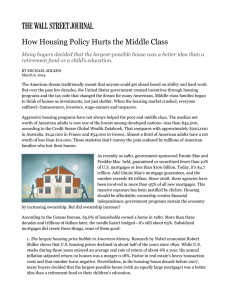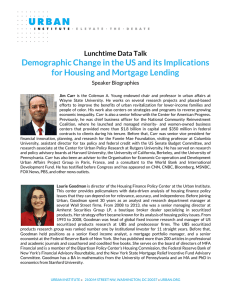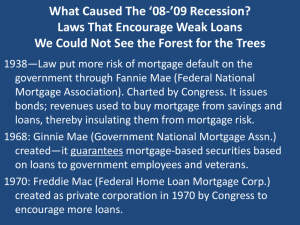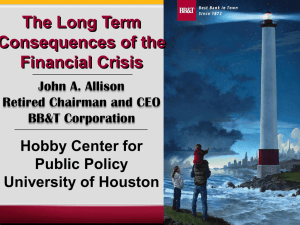HOUSING FINANCE AT A GLANCE A MONTHLY CHARTBOOK October 2013
advertisement
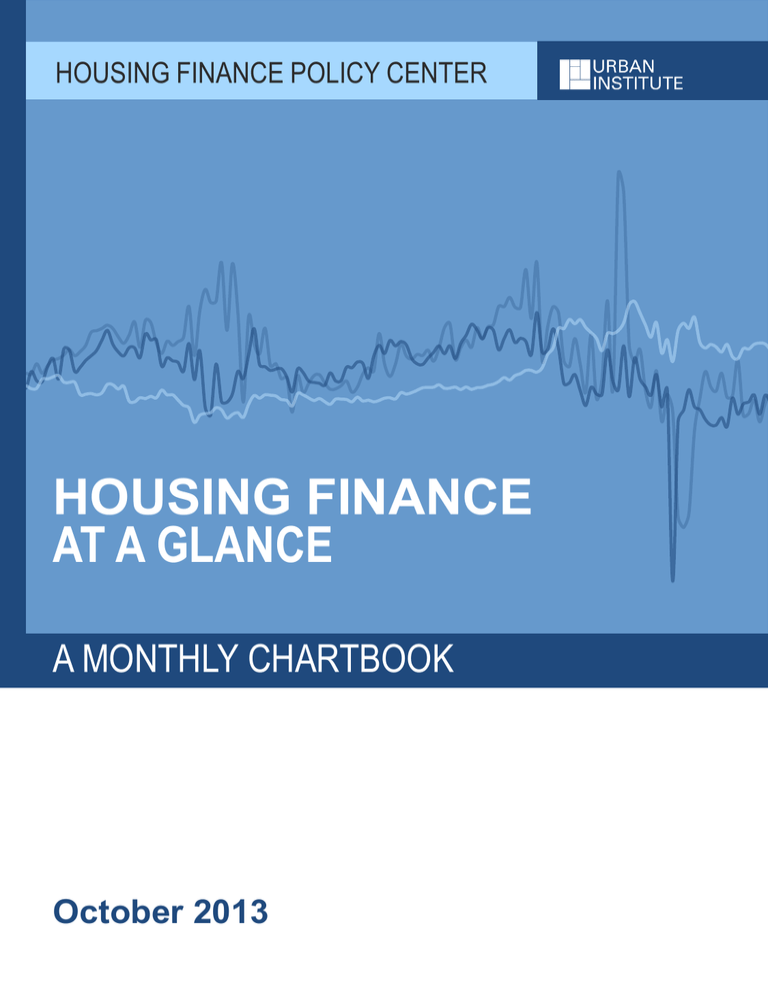
HOUSING FINANCE POLICY CENTER HOUSING FINANCE AT A GLANCE A MONTHLY CHARTBOOK October 2013 1 INTRODUCTION With a decades-long heritage of proven expertise in housing, neighborhoods, jobs, taxes, and other social and economic issues, the Urban Institute is poised to make major contributions to housing finance policy. The new Housing Finance Policy Center will provide timely, impartial data and analysis, and will educate policymakers and the public on how the housing finance system affects households, communities and the broader economy. The Center will bring together data, research, and market and policy expertise on housing and housing finance, and will provide a hub for dialogue based on high-quality, evidence-based analysis. At A Glance is our signature, monthly publication. It is designed as a single reference for mortgage market data, through a public policy lens. Drawing from a range of sources that are often difficult to access and interpret, At A Glance presents key measures of housing affordability, credit availability, and other topics related to the government role in the mortgage market. We present this critical information in a comprehensive and easily digestible format so that stakeholders from all corners of the housing finance sphere—government, advocacy, academia, and private markets—can contribute to datadriven policy debates. At A Glance embodies the Center’s mission of elevating the housing finance debate, and we hope that this publication, along with our other works, will serve as a basis for thoughtful, well-designed housing finance policies that meet the nation’s current and future needs. HOUSING FINANCE POLICY CENTER STAFF Laurie Goodman Center Director Ellen Seidman Senior Fellow Jim Parrott Senior Fellow Jun Zhu Senior Financial Methodologist Wei Li Senior Research Associate Bing Bai Research Associate I Pamela Lee Research Associate II Taz George Research Assistant Maia Woluchem Research Assistant Alison Rincon Special Assistant to the Director INSIDE THIS ISSUE • Non-agency security issuance ticks up slightly (page 8) • Credit box is still tight by key measures (page 10) • Housing affordability drops as prices and interest rates continue to rise, but it varies widely by MSA (page 11) • GSE portfolio wind-down continues; guarantee fees rise (pages 12-14) • Both HAMP and HARP activity tapers off (pages 20-21) • Share of private mortgage insurance activity is increasing but is still far below FHA/VA market share We would like to thank The Citi Foundation and The John D. and Catherine T. MacArthur Foundation for providing generous support at the leadership level to launch the Housing Finance Policy Center. Additional support was provided by the Ford Foundation and the Open Society Foundations. We are also especially grateful to Sarah Rosen Wartell, president of the Urban Institute, and Rolf Pendall, director of the Metropolitan Housing and Communities Policy Center, for their creative visions and valuable insights. Lastly, we would like to thank Lan Shi for her considerable contributions to this edition. We welcome your feedback. Please send any comments or questions to ataglance@urban.org. 2 CONTENTS Overview Market Size Overview Value of the US Residential Housing Market Size of the US Residential Mortgage Market Private-Label Securities by Product Type Agency Mortgage-Backed Securities 5 5 6 6 Origination Volume and Composition First Lien Origination Volume First Lien Origination Share 7 7 Securitization Volume and Composition Agency/Non-Agency Share of Residential MBS Issuance Non-Agency MBS Issuance Non-Agency Securitization 2.0 8 8 8 Agency Activity: Volumes and Purchase/Refi Composition At-Issuance Balance Percent Refi at Issuance 9 9 Credit Availability for Purchase Loans Average Borrower FICO Score at Origination Average Combined LTV at Origination 10 10 Housing Affordability National Housing Affordability Over Time Affordability Adjusted for MSA-Level DTI 11 11 GSEs under Conservatorship GSE Portfolio Wind-Down: Fannie Mae Fannie Mae Mortgage-Related Investment Portfolio Over Time Fannie Mae Mortgage-Related Investments as Share of End Balance 12 12 GSE Portfolio Wind-Down: Freddie Mac Freddie Mac Mortgage-Related Investment Portfolio Over Time Freddie Mac Mortgage-Related Investments as Share of End Balance 13 13 Effective Guarantee Fees Effective Guarantee Fees Risk-Sharing Transactions 14 14 Serious Delinquency Rates Serious Delinquency Rates – Fannie Mae Serious Delinquency Rates – Freddie Mac 15 15 3 CONTENTS Serious Delinquency Rates (cont.) Serious Delinquency Rates – Single-Family Loans Serious Delinquency Rates – Multifamily GSE Loans 16 16 Refinance Activity Total HARP Refinance Volume HARP Refinances 17 17 GSE Loans: Potential Refinances Loans Meeting HARP Pay History Requirements 18 Modification Activity HAMP Activity New HAMP Modifications Cumulative HAMP Modifications 19 19 Modification by Type of Action and Bearer of Risk Changes in Loan Terms for Modifications Type of Modification Action by Investor and Product Type 20 20 Modifications and Liquidations Loan Modifications and Liquidations Cumulative Modifications and Liquidations 21 21 Modification Redefault Rates by Bearer of the Risk Redefault Rate 12 Months after Modification Redefault Rate 24 Months after Modification 22 22 Agency Issuance Agency Gross and Net Issuance Agency Gross Issuance Agency Net Issuance 23 23 Agency Gross Issuance and Fed Purchases Monthly Gross Issuance Fed Absorption of Agency Gross Issuance 24 24 Mortgage Insurance Activity MI Activity since 2011 MI Market Share 25 25 Related HFPC Work Publications and Events 26–7 4 OVERVIEW MARKET SIZE OVERVIEW Home values continue to improve, increasing the total value of the US residential housing market. However, the reliance on mortgage financing is decreasing because of a sizable share of cash purchases and larger down payments. The total size of the mortgage market stands at $9.8 trillion as of Q2 2013. Agency mortgage-backed securities (MBS) make up 56 percent of the total; private-label securities make up 8.6 percent; and unsecuritized first liens at commercial banks, savings institutions, and credit unions make up 22.4 percent. Value of the US Residential Housing Market Size of the US Residential Mortgage Market as of Q2 2013 as of Q2 2013 $25,000 Unsecuritized first liens at commercial banks, savings institutions, credit unions Fannie and Freddie Loans in portfolio $20,000 Agency MBS Equity, $9,772 Private-label securities Equity, $9,772 Second liens $ billions $15,000 $10,000 $10,000 $2,208 $7,500 $ billions $5,000 Debt, household mortgages, $9,833 $537 $5,000 $5,508 $2,500 $0 Sources: Federal Reserve Flow of Funds and Urban Institute. $0 $849 $731 Sources: Federal Reserve Flow of Funds, Inside Mortgage Finance, Fannie Mae, Freddie Mac, and Urban Institute. 5 OVERVIEW MARKET SIZE OVERVIEW Mortgage debt in the private-label securitization market is split among Alt-A (44.4 percent), subprime (35.1 percent), and prime (20.1 percent) loans. The agency market is 47.6 percent Fannie Mae, 28 percent Freddie Mac, and 24.4 percent Ginnie Mae. Private-Label Securities by Product Type as of August 2013; dollars in billions 100% 90% Subprime, $291.9 80% 70% 60% Prime, $170.8 50% 40% 30% Alt-A, $369.5 20% 10% 0% Sources: CoreLogic and Urban Institute. Agency Mortgage-Backed Securities as of Q2 2013; dollars in billions 100% 90% Freddie Mac, $1,545 80% 70% 60% Ginnie Mae, $1,343 50% 40% 30% 20% Fannie Mae, $2,620 10% 0% Sources: Inside Mortgage Finance and Urban Institute. 6 OVERVIEW OVERVIEW ORIGINATION VOLUME AND COMPOSITION First Lien Origination Volume First lien originations through the first half of 2013 at $973 billion were considerably higher than the first 2 quarters of 2012 at $848 billion. However, with higher interest rates and reduced refinancing volume, we expect 2013 mortgage origination numbers to come in marginally lower than the total volume of $1.86 trillion in 2012. $4,000 $3,500 $ billions $3,000 $2,500 Bank portfolio $2,000 PLS total securitization $1,500 FHA/VA securitization $1,000 GSE securitization First Lien Origination Share 2013 (Q1-2) 2012 2011 2010 2009 2008 2007 2006 2005 2004 2003 2002 $0 2001 $500 Sources: Inside Mortgage Finance and Urban Institute. The GSE share of first lien originations remains elevated compared with historical levels, now sitting at 67 percent. Likewise, FHA and VA continue to hold a much larger share, with 20.5 percent of the market. While private-label originations are less than 1 percent, that constitutes an increase from the depths of the recession, when such originations all but disappeared. 100% 90% Bank portfolio 80% 70% PLS total securitization 60% FHA/VA securitization 50% 40% GSE securitization 30% 20% 2013 2013 (Q1-2) (Q1-2) 2012 2011 2010 2009 2008 2007 2006 2005 2004 2003 2002 0% 2001 10% Sources: Inside Mortgage Finance and Urban Institute. 7 OVERVIEW SECURITIZATION VOLUME AND COMPOSITION 2012 2011 2010 2009 2008 2007 2006 Non-Agency share Sources: Inside Mortgage Finance and Urban Institute. Non-Agency MBS Issuance 2013 (Q1-Q3) Agency share 2005 2004 2003 2002 2001 2000 1999 1998 1997 1996 Non-agency single-family MBS issuance has ticked up but remains 100% less than 2 percent of the market for 2013 through September. Over 90% this period, total non-agency 80% issuance was $25.4 billion, 70% compared with $10.3 billion in the first three quarters of 2012. This 60% represents significant progress, but 50% still pales in comparison to non40% agency numbers in the pre-bubble years such as 2002, when issuance 30% reached $400 billion annually. The 20% Non-Agency Securitization 2.0 10% graph shows that newly issued securities are finally coming back 0% with consistent monthly issuance, albeit slowly. 1995 Agency/Non-Agency Share of Residential MBS Issuance Non-Agency Securitization 2.0 $1,200 $12 $1,000 $10 $8 $600 $ billions $400 $200 $4 Alt A All other Sources: Inside Mortgage Finance and Urban Institute. Sources: Inside Mortgage Finance and Urban Institute. Note: Monthly figures equal total non-agency MBS issuance minus Re-REMIC issuance. 8 Sep-13 Jul-13 May-13 Mar-13 Jan-13 Nov-12 Sep-12 Jul-12 May-12 Jan-12 Mar-12 Nov-11 Sep-11 Jul-11 May-11 Mar-11 Jan-11 2001 2002 2003 2004 2005 2006 2007 2008 2009 2010 2011 2012 2013 YTD (Q1-Q3) Subprime $0 Nov-10 $2 $0 Prime $6 Sep-10 $ billions $800 OVERVIEW AGENCY ACTIVITY: VOLUMES AND PURCHASE/REFI COMPOSITION Agency issuance for the first eight months of 2013 totaled $839.4 billion. The Ginnie Mae share has declined, courtesy of large increases in FHA mortgage insurance premiums. In August, refinances represented 60–70 percent of the GSE business, down from over 80 percent in January. The Ginnie Mae market has always been more purchase-driven, with refinance volume down from 56 percent in January to 34 percent now. At-Issuance Balance Freddie Mac Fannie Mae Ginnie Mae $2,500 $ billions $2,000 $1,500 $1,000 $500 $0 2000 2001 2002 2003 2004 2005 2006 2007 2008 2009 2010 2011 2012 2013 YTD Sources: eMBS and Urban Institute. Note: Year to date as of August 2013. Percent Refi at Issuance Freddie Mac Fannie Mae Ginnie Mae Aug-13 Apr-13 Dec-12 Aug-12 Apr-12 Dec-11 Apr-11 Aug-11 Dec-10 Aug-10 Apr-10 Dec-09 Apr-09 Aug-09 Dec-08 Aug-08 Apr-08 Dec-07 Apr-07 Aug-07 Dec-06 Apr-06 Aug-06 Dec-05 Aug-05 Apr-05 Dec-04 Apr-04 Aug-04 Dec-03 Aug-03 Apr-03 90% 80% 70% 60% 50% 40% 30% 20% 10% 0% Sources: eMBS and Urban Institute. Note: Based on at-issuance balance. 9 OVERVIEW OVERVIEW CREDIT CREDIT AVAILABILITY AVAILABILITY FOR FOR PURCHASE LOANS Access to credit has become extremely limited, especially for borrowers with low FICO scores. LTV levels at origination remain relatively high, primarily due to the large number of FHA purchase originations. Average Borrower FICO Score at Origination 750 740 FICO Score 730 720 710 700 690 680 Jun-13 Dec-12 Jun-12 Dec-11 Jun-11 Dec-10 Jun-10 Dec-09 Jun-09 Dec-08 Jun-08 Dec-07 Jun-07 Dec-06 Jun-06 Dec-05 Jun-05 Dec-04 Jun-04 Dec-03 Jun-03 Dec-02 Jun-02 Dec-01 Jun-01 670 Sources: CoreLogic Prime Servicing as of August 2013 and Urban Institute. Note: Purchase-only loans. Average Combined LTV at Origination 90 88 86 84 LTV 82 80 78 76 74 72 Jun-13 Dec-12 Jun-12 Dec-11 Jun-11 Dec-10 Jun-10 Dec-09 Jun-09 Dec-08 Jun-08 Dec-07 Jun-07 Dec-06 Jun-06 Dec-05 Jun-05 Dec-04 Jun-04 Dec-03 Jun-03 Dec-02 Jun-02 Dec-01 Jun-01 70 Sources: CoreLogic Prime Servicing as of August 2013 and Urban Institute. Note: Purchase-only loans. 10 OVERVIEW HOUSING AFFORDABILITY In August, the US median home price reached highs last seen in December 2004. While this indicates that a housing recovery is underway, it also suggests a shifting landscape of affordability. National Housing Affordability Over Time Maximum affordable price is calculated as the house price that a family can afford based on the following assumptions: 20% down payment, monthly payment of 28% of median family income (US Census), Freddie Mac prevailing mortgage rate for 30-year fixedrate mortgage, and property tax and property insurance at 1.75% of housing value. $300,000 Housing prices $280,000 Credit bubble $260,000 $240,000 $220,000 $200,000 $180,000 $160,000 $140,000 Dec-99 Jun-00 Dec-00 Jun-01 Dec-01 Jun-02 Dec-02 Jun-03 Dec-03 Jun-04 Dec-04 Jun-05 Dec-05 Jun-06 Dec-06 Jun-07 Dec-07 Jun-08 Dec-08 Jun-09 Dec-09 Jun-10 Dec-10 Jun-11 Dec-11 Jun-12 Dec-12 Jun-13 $120,000 Median MedianSales salesPrice price Max Affordable Max affordablePrice price Max Prc at 6.0% MaxAfd affordable priceRate at 6.0% rate Sources: CoreLogic, US Census, Freddie Mac, and Urban Institute. LAS VEGAS-PARADISE, NV Sources: CoreLogic, US Census, Freddie Mac, and UI calculations based on NAR methodology. Note: Affordability index is calculated relative to home prices in 2000-03. A ratio above 1 indicates higher affordability today than in 2000-03. 11 DETROIT-LIVONIA-DEARBORN, MI CLEVELAND-ELYRIA-MENTOR, OH TAMPA-ST. PETERSBURG-CLEARWATER, FL SACRAMENTO--ARDEN-ARCADE--ROSEVILLE, CA CHICAGO-JOLIET-NAPERVILLE, IL OAKLAND-FREMONT-HAYWARD, CA CINCINNATI-MIDDLETOWN, OH-KY-IN RIVERSIDE-SAN BERNARDINO-ONTARIO, CA KANSAS CITY, MO-KS ORLANDO-KISSIMMEE-SANFORD, FL COLUMBUS, OH PITTSBURGH, PA MINNEAPOLIS-ST. PAUL-BLOOMINGTON, MN-WI ST. LOUIS, MO-IL SAN DIEGO-CARLSBAD-SAN MARCOS, CA NASSAU-SUFFOLK, NY DENVER-AURORA-BROOMFIELD, CO BOSTON-QUINCY, MA BALTIMORE-TOWSON, MD SAN ANTONIO-NEW BRAUNFELS, TX FORT WORTH-ARLINGTON, TX PHOENIX-MESA-GLENDALE, AZ ATLANTA-SANDY SPRINGS-MARIETTA, GA NEWARK-UNION, NJ-PA MIAMI-MIAMI BEACH-KENDALL, FL SEATTLE-BELLEVUE-EVERETT, WA HOUSTON-SUGAR LAND-BAYTOWN, TX PORTLAND-VANCOUVER-HILLSBORO, OR-WA PHILADELPHIA, PA DALLAS-PLANO-IRVING, TX SAN JOSE-SUNNYVALE-SANTA CLARA, CA NEW YORK-WHITE PLAINS-WAYNE, NY-NJ LOS ANGELES-LONG BEACH-GLENDALE, CA 1.4 1.3 1.2 1.1 1.0 0.9 0.8 0.7 WASHINGTON-ARLINGTON-ALEXANDRIA, DC-VA Ratio Affordability Adjusted for MSA-Level DTI OVERVIEW GSES UNDER CONSERVATORSHIP GSE PORTFOLIO WIND DOWN: GSE PORTFOLIO WIND-DOWN: FANNIE MAE FANNIE MAE Under conservatorship, both Fannie Mae and Freddie Mac have been ordered to begin winding down their portfolios. This has shrunk both portfolios and shifted their mix, as the agency MBS share is shrinking more rapidly than the less liquid assets (mortgage loans and non-agency MBS). Agency MBS now comprises 28.7 percent of the Fannie portfolio and 41.3 percent of the Freddie portfolio. Both GSEs will be well under their portfolio cap of $552.5 billion for year-end 2013. Fannie now stands at $531.3 billion and Freddie at $511.9 billion. Fannie Mae Mortgage-Related Investment Portfolio 900 Over Time 800 700 $ billions Current size: $531.3 billion Current cap: $552.5 billion Shrinkage year to date: 14.4% 600 500 400 300 Mortgage loans Non-agency MBS Non-FNMA agency MBS FNMA MBS in portfolio 200 100 Aug-13 Mar-13 Oct-12 May-12 Dec-11 Jul-11 Feb-11 Sep-10 Apr-10 Nov-09 Jun-09 Jan-09 Aug-08 Mar-08 Oct-07 May-07 Dec-06 Sources: Fannie Mae and Urban Institute. Jul-06 Feb-06 0 Fannie Mae Mortgage-Related Investments as Share of End Balance 60% 50% 40% 30% 20% 10% Aug-13 Mar-13 Oct-12 May-12 Dec-11 Jul-11 Feb-11 Sep-10 Apr-10 Nov-09 Jun-09 Jan-09 Aug-08 Mar-08 Sources: Fannie Mae and Urban Institute. Oct-07 0% FNMA MBS in portfolio May-07 Non-FNMA agency MBS 70% Dec-06 Non-agency MBS 80% Jul-06 Mortgage loans 90% Feb-06 Less liquid assets (mortgage loans and nonagency MBS) = 71% Percentage of end balance 100% 12 OVERVIEW GSES UNDER CONSERVATORSHIP GSE PORTFOLIO WIND DOWN: GSE PORTFOLIO FREDDIE MAC WIND-DOWN: FREDDIE MAC Freddie Mac Mortgage-Related Investment Portfolio Over Time 1,000 900 Current size: $511.9 billion Current cap: $552.5 billion Shrinkage year to date: 6.9% 800 $ billions 700 600 500 400 300 Mortgage loans 200 Non-agency MBS 100 Non-FHLMC agency MBS May-12 Oct-12 Mar-13 May-12 Oct-12 Mar-13 Aug-13 Dec-11 Jul-11 Dec-11 Feb-11 Sep-10 Apr-10 Nov-09 Jun-09 Jan-09 Aug-08 Mar-08 Oct-07 May-07 Dec-06 Feb-06 Sources: Freddie Mac and Urban Institute. Jul-06 0 FHLMC MBS in portfolio Freddie Mac Mortgage-Related Investments as Share of End Balance 60% 50% 40% 30% 20% 10% Aug-13 Jul-11 Feb-11 Sep-10 Apr-10 Nov-09 Jun-09 Jan-09 Aug-08 Mar-08 Sources: Freddie Mac and Urban Institute. 0% Oct-07 FHLMC MBS in portfolio May-07 Non-FHLMC agency MBS 70% Dec-06 Non-agency MBS 80% Jul-06 Mortgage loans 90% Feb-06 Less liquid assets (mortgage loans and nonagency MBS) = 59% Percentage of end balance 100% 13 GSES UNDER CONSERVATORSHIP EFFECTIVE GUARANTEE FEES Effective Guarantee Fees 60 56.9 35.8 31.6 30 20 10 Fannie Mae single-family effective g-fee rate Freddie Mac single-family effective g-fee rate 1Q09 27.9 19.1 Fannie Mae single-family average charged g-fee on new acquisitions 21.0 2Q09 26.1 19.3 23.7 3Q09 29.3 18.1 24.7 4Q09 27.9 18.7 23.8 1Q10 24.4 18.1 26.9 2Q10 25.0 18.5 27.3 3Q10 25.2 19.9 25.3 4Q10 25.1 19.5 25.7 1Q11 26.0 19.1 26.1 2Q11 26.1 18.7 31.6 3Q11 26.1 20.3 31.1 4Q11 26.2 20.2 28.8 1Q12 26.8 23.2 28.9 2Q12 27.7 24.1 40.3 3Q12 28.3 26.5 41.8 4Q12 28.7 25.9 39.9 1Q13 33.5 30.4 54.4 2Q13 35.8 31.6 56.9 Quarter 2Q13 1Q13 4Q12 3Q12 2Q12 1Q12 4Q11 3Q11 2Q11 1Q11 4Q10 3Q10 2Q10 1Q10 4Q09 3Q09 0 2Q09 Sources: Fannie Mae, Freddie Mac, and Urban Institute. 40 1Q09 FNMA Effective G-Feeg-fee FannieSingle-Family Mae single-family effective Rate rate FannieSingle-Family Mae single-family average FNMA Average Charged G-Fee on g-fee New Acquisitions charged on new acquisitions FreddieManagement Mac management and g-fee FHLMC and G-Fee Raterate 50 Basis points Effective g-fees on new Fannie acquisitions rose to 56.9 bps in Q2, and we expect the increases to continue. Freddie does not report the g-fee on new acquisitions, only the effective g-fee on the entire book of business. This is up to 31.6 bps. These gfee increases have not yet begun to shift significant amounts of activity away from the GSEs, but we expect that g-fees are close to the point where this will occur. Risk-Sharing Transactions As part of its strategic plan for 2013–17, the Federal Housing Finance Agency directed Fannie Mae and Freddie Mac to pursue risksharing transactions, with the goal of ultimately reducing taxpayer exposure to credit risk. In July, Freddie Mac completed its first risksharing deal, issuing $500 million in debt as part of a Structured Agency Credit Risk (STACR) bond to 50 different buyers. Freddie plans to issue its second STACR bond toward the end of the year. In early October, Fannie Mae completed its own risk-sharing transaction, Connecticut Avenue Securities. The $675 million deal was structured very similarly to the Freddie deal. The biggest difference was that the M-1 bond in the Fannie deal was rated. The Fannie deal priced much tighter than the Freddie deal, and both deals are currently trading tighter than original pricing levels, indicating investors are developing a level of comfort taking on new mortgage credit risk. Sources: Fannie Mae, Freddie Mac, and Urban Institute. Note: G-fees are in basis points. 14 OVERVIEW SERIOUS DELINQUENCY RATES AT GSES UNDER CONSERVATORSHIP SERIOUS THE GSEsDELINQUENCY RATES Serious delinquency rates at the GSEs continue to decline as the legacy portfolio is resolved and the pristine, post-2009 book of business exhibits very low default rates. Currently 2.61 percent of the Fannie portfolio and 2.64 percent of the Freddie portfolio are seriously delinquent, down from 3.44 percent and 3.36 percent a year earlier, respectively . Serious Delinquency Rates–Fannie Mae Percentage of total loans 16% 14% 12% 10% 8% Single-family: Non-credit enhanced 6% 4% Single-family: Credit enhanced 2% Single-family: Total Jan-04 Jun-04 Nov-04 Apr-05 Sep-05 Feb-06 Jul-06 Dec-06 May-07 Oct-07 Mar-08 Aug-08 Jan-09 Jun-09 Nov-09 Apr-10 Sep-10 Feb-11 Jul-11 Dec-11 May-12 Oct-12 Mar-13 Aug-13 0% Sources: Fannie Mae and Urban Institute. Serious Delinquency Rates–Freddie Mac 10% 8% 7% 6% 5% Single-family: Non-credit enhanced 4% Single-family: Credit enhanced 3% 2% Single-family: Total 1% 0% Jan-04 Jun-04 Nov-04 Apr-05 Sep-05 Feb-06 Jul-06 Dec-06 May-07 Oct-07 Mar-08 Aug-08 Jan-09 Jun-09 Nov-09 Apr-10 Sep-10 Feb-11 Jul-11 Dec-11 May-12 Oct-12 Mar-13 Aug-13 Percentage of total loans 9% Sources: Freddie Mac and Urban Institute. 15 GSES UNDER CONSERVATORSHIP SERIOUS DELINQUENCY RATES As the housing market heals, the serious delinquency rates on both FHA and GSE single-family loans continue to decline, albeit from a much higher starting point for the FHA loans. GSE multifamily delinquency rates are also declining from an already very low level. Serious Delinquency Rates–Single-Family Loans FHA Fannie Mae Freddie Mac Percentage of total loans 10% 9% 8% 7% 6% 5% 4% 3% 2% 1% 2Q13 1Q13 4Q12 3Q12 2Q12 4Q11 Dec-11 1Q12 3Q11 2Q11 Aug-11 1Q11 4Q10 3Q10 2Q10 1Q10 4Q09 3Q09 2Q09 1Q09 4Q08 3Q08 2Q08 1Q08 4Q07 3Q07 2Q07 1Q07 4Q06 3Q06 2Q06 1Q06 4Q05 3Q05 2Q05 1Q05 0% Sources: Fannie Mae, Freddie Mac, MBA Delinquency Survey, and Urban Institute. Serious Delinquency Rates–Multifamily GSE Loans Fannie Mae Freddie Mac Percentage of total loans 0.9% 0.8% 0.7% 0.6% 0.5% 0.4% 0.3% 0.2% 0.1% Sources: Fannie Mae, Freddie Mac, and Urban Institute. 16 Aug-13 Apr-13 Dec-12 Aug-12 Apr-12 Apr-11 Dec-10 Aug-10 Apr-10 Dec-09 Aug-09 Apr-09 Dec-08 Aug-08 Apr-08 Dec-07 Aug-07 Apr-07 Dec-06 Aug-06 Apr-06 Dec-05 Aug-05 Apr-05 Dec-04 Aug-04 Apr-04 0.0% GSES UNDER CONSERVATORSHIP REFINANCE ACTIVITY The Home Affordable Refinance Program (HARP) refinances have begun to slow. Two factors are responsible for this: (1) higher interest rates, leaving fewer eligible loans where refinancing is economically advantageous (in-the-money), and (2) a considerable number of borrowers who have already refinanced. There have been over 18 million refinances of GSE loans since Q2 2009, 2.9 million of these through HARP. As a result, the pool of eligible loans remaining is much lower. Total HARP Refinance Volume HARP refinance volume - Fannie HARP refinance volume - Freddie 350,000 300,000 250,000 200,000 150,000 100,000 50,000 0 2Q09 3Q09 4Q09 1Q10 2Q10 3Q10 4Q10 1Q11 2Q11 3Q11 4Q11 1Q12 2Q12 3Q12 4Q12 1Q13 2Q13 Sources: FHFA Refinance Report and Urban Institute. HARP Refinances August 2013 Year to date 2013 Inception to date 2012 2011 2010 Total refinances 302,373 3,340,221 18,130,561 4,750,530 3,229,066 3,604,640 Total HARP refinances 68,340 721,813 2,886,856 1,074,769 400,024 431,647 Share >80–105 LTV 62.7% 58.4% 70.0% 56.4% 85.0% 93.4% Share >105–125 LTV 20.6% 21.6% 17.1% 22.4% 15.0% 6.6% Share >125 LTV 16.6% 20.0% 12.9% 21.2% 0% 0% 54,310 585,155 2,908,093 729,235 785,049 763,477 All other streamlined refinances Sources: FHFA Refinance Report and Urban Institute. 17 OVERVIEW GSES UNDER CONSERVATORSHIP GSE LOANS: DISTRIBUTION OF GSE LOANS:REFINANCES POTENTIAL POTENTIAL REFINANCES To qualify for HARP, a loan must be originated before June 2009, have a marked-to-market loan-to-value (MTM LTV) ratio above 80, and have no more than one delinquent payment in the past year and none in the past six months. There are 1,617,838 eligible loans, but 34 percent are out-of-the-money because the closing cost would exceed the long-term savings, leaving 1,073,985 loans where a HARP refinance is both permissible and economically advantageous for the borrower. Loans below the LTV minimum but meeting all other HARP requirements are eligible for GSE streamlined refinancing. Of the 7,857,302 loans in this category, 5,171,731 are in-the-money. More than half the GSE book of business was originated after the cutoff date. Of these loans, 2,192,865 meet the other HARP criteria, but 91 percent are out-of-the-money, leaving only 188,840 loans that, if there was a change in the eligibility date, would be potential HARP candidates at current interest rate levels. Total loan count 24,221,940 Loans that don't meet pay history requirement 2,128,518 Loans that meet pay history requirement: 22,093,422 Pre-June 2009 origination 9,475,140 Post-June 2009 origination 12,618,282 Loans Meeting HARP Pay History Requirements LTV category Pre-June 2009 In-the-money Out-of-the-money Total ≤80 5,171,731 2,685,571 7,857,302 ≥80 1,073,985 543,853 1,617,838 Total 6,245,716 3,229,424 9,475,140 LTV category In-the-money Out-of-the-money Total ≤80 529,903 9,895,514 10,425,417 ≥80 188,840 2,004,025 2,192,865 Total 718,743 11,899,539 12,618,282 Post-June 2009 Source: CoreLogic prime servicing data as of August 2013. Note: Figures are scaled up from source data by a factor of 1/.65 to account for data coverage. Striped box indicates HARP-eligible loans that are in-the-money. 18 MODIFICATION ACTIVITY HAMP ACTIVITY HAMP modification activity has tapered off as new defaults have declined. However, modification success rates are improving so the number of new active permanent modifications remains fairly stable. New HAMP Modifications New trial mods started New permanent mods started New active permanent mods Number of mods (thousands) 180 160 140 120 100 80 60 40 20 Aug-13 Jun-13 Apr-13 Feb-13 Dec-12 Oct-12 Aug-12 Jun-12 Apr-12 Feb-12 Dec-11 Oct-11 Aug-11 Jun-11 Apr-11 Feb-11 Dec-10 Oct-10 Aug-10 Jun-10 Apr-10 Feb-10 Dec-09 Oct-09 Aug-09 Jun-09 0 Sources: US Treasury Making Home Affordable Program and Urban Institute. Cumulative HAMP Modifications Number of mods (thousands) All trials mods started All permanent mods started Active permanent mods 2,500 2,000 1,500 1,000 500 Aug-13 Jun-13 Apr-13 Feb-13 Dec-12 Oct-12 Aug-12 Jun-12 Apr-12 Feb-12 Dec-11 Oct-11 Aug-11 Jun-11 Apr-11 Feb-11 Dec-10 Oct-10 Aug-10 Jun-10 Apr-10 Feb-10 Dec-09 Oct-09 Aug-09 Jun-09 0 Sources: US Treasury Making Home Affordable Program and Urban Institute. 19 MODIFICATION BY TYPE OF ACTION MODIFICATION BYOF TYPE AND BY BEARER RISKOF ACTION AND BEARER OF RISK MODIFICATION ACTIVITY OVERVIEW The share of principal reduction modifications peaked at 20 percent in December 2012 and has dropped in the past two quarters. This is to be expected, as increasing home prices have, in turn, increased equity, reducing the need for principal reduction and making such modifications less likely to be net-present-value positive. Principal reduction is more likely to be done on private investor loans, followed by portfolio loans. The GSEs and FHA/VA do not allow this type of modification. Changes in Loan Terms for Modifications One quarter % change 3.0 One year % change 4.4 6/30/12 9/30/12 12/31/12 3/31/13 6/30/13 Capitalization 78.3 88.2 84.6 79.3 81.7 Rate reduction 78.7 77.1 73.3 80.1 81.0 1.1 2.8 Rate freeze 6.3 7.1 3.9 3.7 5.2 40.5 -17.1 Term extension 62.1 64.9 58.9 60.3 67.7 12.2 9.0 Principal reduction 15.4 17.2 20.0 15.2 12.1 -20.0 -21.4 19.7 19.0 20.5 18.2 20.5 12.4 3.9 0.7 0.4 1.1 0.6 1.4 117.4 89.2 Principal deferral a Not reported Sources: OCC Mortgage Metrics Report for the Second Quarter of 2013 and Urban Institute. Note: This table represents percentage of total modifications in each category. a. Processing constraints at some servicers prevented them from reporting specific modified term(s). Type of Modification Action by Investor and Product Type 96.2 Governmentguaranteed 75.6 Private investor 86.1 66.2 85.4 96.1 11.8 3.4 82.9 Fannie Mae Freddie Mac Capitalization 87.6 Rate reduction Rate freeze Term extension Principal reduction Principal deferral Not reported Portfolio Overall 69.9 81.7 73.2 79.4 81.0 0.3 6.1 5.7 5.2 90.2 95.6 19.8 47.2 67.7 0.0 0.0 0.2 27.5 36.5 12.1 24.8 41.0 0.2 36.8 16.6 20.5 2.9 0.3 0.3 1.8 1.8 1.4 a Sources: OCC Mortgage Metrics Report for the Second Quarter of 2013 and Urban Institute. Note: This table represents percentage of total modifications in each category. a. Processing constraints at some servicers prevented them from reporting specific modified term(s). 20 MODIFICATION ACTIVITY MODIFICATIONS AND LIQUIDATIONS Total modifications (HAMP and proprietary) are now roughly equal to total liquidations. Hope Now numbers show 6,724,422 borrowers have received a modification since Q3 2007, compared with 6,676,474 liquidations in the same period. Loan Modifications and Liquidations Number of loans 1,600,000 HAMP permanent mods 1,400,000 Proprietary mods completed 1,200,000 Total liquidations 1,000,000 800,000 600,000 400,000 200,000 0 2007 (Q3-Q4) 2008 2009 2010 2011 2012 2013 YTD Sources: Hope Now and Urban Institute. Notes: Total liquidations includes both foreclosure sales and short sales. 2013 figures are through August. Cumulative Modifications and Liquidations 7,000,000 HAMP mods Number of loans 6,000,000 Proprietary mods Liquidations 5,000,000 4,000,000 3,000,000 2,000,000 1,000,000 0 2007 2007 (Q3Q4) (Q3-Q4) 2008 2009 2010 2011 2012 2013 2013 YTD YTD Sources: Hope Now and Urban Institute. Notes: Total liquidations includes both foreclosure sales and short sales. 2013 figures are through August. 21 MODIFICATION ACTIVITY MODIFICATION REDEFAULT RATES BY BEARER OF THE RISK Redefault rates have come down across each sector, especially on private-label modifications. Governmentguaranteed mortgages have much higher redefault rates than other product types. Redefault Rate 12 Months after Modification 80% 70% Fannie Mae Governmentguaranteed Private Redefault rate Freddie Mac 60% 50% 40% 30% Portfolio loans 20% Overall 10% 0% 2008 2009 2010 Year of modification 2011 2012 Sources: OCC Mortgage Metrics Report for the Second Quarter of 2013 and Urban Institute. Redefault Rate 24 Months after Modification 80% Fannie Mae 70% Freddie Mac Private Portfolio loans Overall Redefault rate Governmentguaranteed 60% 50% 40% 30% 20% 10% 0% 2008 2009 2010 Year of modification 2011 Sources: OCC Mortgage Metrics Report for the Second Quarter of 2013 and Urban Institute. 22 AGENCY ISSUANCE AGENCY GROSS AND NET ISSUANCE While newly issued agency securities (agency gross issuance) have been robust year to date, much of the issuance has been driven by refinancing. As that activity falls off with rising interest rates, we expect the volume of new issuance to fall off as well. Net issuance, which excludes repayments, prepayments, and refinances on outstanding mortgages, remains low and dominated by Ginnie Mae. This is unsurprising, given the increased role of FHA and VA during the crisis. Agency Gross Issuance ($ billions) Agency Net Issuance ($ billions) Year GSE GNMA Total Year GSE GNMA Total 2000 360.6 102.2 462.8 2000 159.8 29.3 189.1 2001 885.1 171.5 1,056.6 2001 367.8 -9.9 357.9 2002 1,238.9 169.0 1,407.9 2002 357.6 -51.2 306.4 2003 1,874.9 213.1 2,088.0 2003 335.0 -77.6 257.4 2004 872.6 119.2 991.9 2004 83.3 -40.1 43.2 2005 893.9 81.4 975.3 2005 174.4 -42.2 132.1 2006 853.0 76.7 929.7 2006 313.6 0.3 313.8 2007 1,066.2 94.9 1,161.1 2007 514.7 30.9 545.5 2008 911.4 267.6 1,179.0 2008 314.3 196.4 510.7 2009 1,279.9 451.3 1,731.3 2009 249.5 257.4 506.8 2010 1,003.5 390.7 1,394.3 2010 -305.5 198.2 -107.3 2011 879.3 315.3 1,194.7 2011 -133.4 149.4 16.0 2012 1,288.8 405.0 1,693.8 2012 -46.5 118.4 71.9 2013 (Ann.) 1,365.5 439.3 1,804.7 2013 (Ann.) 63.3 88.8 152.1 2013 YTD 910.3 292.8 1,203.2 2013 YTD 42.2 59.2 101.4 Sources: eMBS, Federal Reserve Bank of New York, and Urban Institute. Note: Year to date through August 2013. Sources: eMBS, Federal Reserve Bank of New York, and Urban Institute. Note: Year to date through August 2013. 23 OVERVIEW AGENCY ISSUANCE OVERVIEW AGENCY GROSS AND NET ISSUANCE AGENCY GROSS ISSUANCE AND FED BY MONTH PURCHASES Monthly Gross Issuance $250 $200 $ billions While government and GSE lending have dominated the mortgage market since the crisis, there has been a change in the mix. The Ginnie Mae share reached a peak of 28% of total agency issuance in 2010, and that share has declined to 24% over the first 8 months of 2013. It should begin to rise again as we move from a refinance market to a purchase market. August showed a Ginnie Mae share of 25.1%. $150 $100 $50 Ginnie Mae Fannie Mae $0 Sources: eMBS, Federal Reserve Bank of New York, and Urban Institute. Feb-05 May-05 Aug-05 Nov-05 Feb-06 May-06 Aug-06 Nov-06 Feb-07 May-07 Aug-07 Nov-07 Feb-08 May-08 Aug-08 Nov-08 Feb-09 May-09 Aug-09 Nov-09 Feb-10 May-10 Aug-10 Nov-10 Feb-11 May-11 Aug-11 Nov-11 Feb-12 May-12 Aug-12 Nov-12 Feb-13 May-13 Aug-13 Freddie Mac Fed Absorption of Agency Gross Issuance The Fed has absorbed 46 percent of gross issuance this year. This number is expected to rise as the Fed continues to react to slow improvement in the labor market, as they announced in September. Gross issuance Fed purchases $250 $ billions $200 $150 $100 $50 Aug-00 Dec-00 Apr-01 Aug-01 Dec-01 Apr-02 Aug-02 Dec-02 Apr-03 Aug-03 Dec-03 Apr-04 Aug-04 Dec-04 Apr-05 Aug-05 Dec-05 Apr-06 Aug-06 Dec-06 Apr-07 Aug-07 Dec-07 Apr-08 Aug-08 Dec-08 Apr-09 Aug-09 Dec-09 Apr-10 Aug-10 Dec-10 Apr-11 Aug-11 Dec-11 Apr-12 Aug-12 Dec-12 Apr-13 Aug-13 $0 Sources: eMBS, Federal Reserve Bank of New York, and Urban Institute. 24 AGENCY ISSUANCE MORTGAGE INSURANCE ACTIVITY MI Activity since 2011 $180,000 $160,000 $140,000 $120,000 $ millions In the years of the housing crisis, private mortgage insurers lost much of their share of the market to FHA and VA. Thanks to the recovery of the market and FHA’s recently heightened mortgage insurance premium, the private mortgage insurance share is now increasing, albeit slowly. $100,000 $80,000 $60,000 $40,000 $20,000 VA FHA $0 Total private primary MI 1Q11 2Q11 3Q11 4Q11 1Q12 2Q12 3Q12 4Q12 1Q13 2Q13 Sources: Inside Mortgage Finance and Urban Institute. MI Market Share Total private primary MI FHA VA 100% 90% 80% 70% 60% 50% 40% 30% 20% 10% 0% 1998 1999 2000 2001 2002 2003 2004 2005 2006 2007 2008 2009 2010 2011 2012 2013 Q1-Q2 Sources: Inside Mortgage Finance and Urban Institute. 25 RELATED HFPC WORK PUBLICATIONS AND EVENTS Issue Papers and Briefs Reps and Warrants: Lessons from the GSEs Experience Authors: Laurie Goodman, Jun Zhu October 24, 2013 GSE credit has become very tight, with a significant increase in the average credit score of approved loans. How Fannie Mae and Freddie Mac are enforcing their Representations and Warranties (Reps and Warrants) rights is playing a significant role in this phenomenon. In this paper, we use the recently released Freddie Mac and Fannie Mae loan level credit data and find that put-backs are having an outsized chilling effect on lower FICO/higher LTV loans. The GSE Reform Debate: How Much Capital Is Enough? Authors: Laurie Goodman, Jun Zhu October 24, 2013 This paper shows that collateral composition, house price experience, and diversification significantly affect credit risk, and thus the amount of private capital needed in front of any government catastrophic guarantee of mortgages in the secondary market. Eminent Domain: The Debate Distracts from Pressing Problems Author: Pamela Lee October 24, 2013 Richmond, CA, has taken steps to become the first city in the nation to vote to use its powers of eminent domain to seize underwater loans and, the city argues, prevent foreclosures and neighborhood blight. We look at several cities that have considered this controversial strategy, evaluating what they have in common, and whether the plan, as proposed, will address the problems they face. QRM Comment Letter: Credit Risk Retention Author: Laurie Goodman October 24, 2013 On August 22, the six regulatory agencies proposed rules for risk retention under Section 941 of the Dodd Frank Act. In this comment letter, we focused on one aspect of the proposal, the Qualified Residential Mortgage (QRM) definition for residential mortgage backed securities. Opening the Credit Box Authors: Jim Parrott, Mark Zandi September 30, 2013 A sustained recovery of the housing market is critical to the recovery of the broader economy. Yet overly tight credit is hampering housing demand and slowing this market's return to health. Mark Zandi and Jim Parrott discuss what is driving this tightness in lending and what policymakers can (and can't) do to address the challenge. Upcoming The Impact of Mortgage Rate Increases on Housing Affordability Author: Lan Shi To measure the impact of the housing recovery on home affordability, we adapt the methodology used by the National Association of Realtors (NAR) in its Housing Affordability Index (HAI). We measure affordability in the United States and across the 37 largest Metropolitan Statistical Areas (MSAs). 26 RELATED HFPC WORK PUBLICATIONS AND EVENTS Upcoming Events Data, Demand, and Demographics: A Symposium on Housing Finance The Urban Institute and CoreLogic are pleased to host a symposium on November 20, 2013 addressing a diverse range of future housing market issues and opportunities confronting consumers, businesses, and policy makers. The symposium will feature keynote addresses from Gene Sperling, director of the National Economic Council, and Ed Glaeser, Fred and Eleanor Glimp Professor of Economics at Harvard University. The program also includes the following panel discussions: Demographics of US Households, Greater Transparency in the Agency and Non-Agency MBS Markets, Challenges of the Rental Market, and Credit Access. Blog Posts Webcasts Lunchtime Data Talk: Mortgage Origination Data— Pricing and Volume: More than You Ever Wanted to Know QRM vs. alternative QRM: quantifying the comparison Presenters: Frank Nothaft (Chief Economist, Freddie Mac) and Michael Fratantoni (Vice President, Single Family Authors: Laurie Goodman, Ellen Seidman, Jun Zhu Research and Policy Development, Mortgage Bankers What HMDA data say about the state of the mortgage Association) October 16, 2013 market Author: Ellen Seidman Lunchtime Data Talk: Home Price Indices: Appreciating Fannie Mae reduces its max LTV to 95: Does the data the Differences Presenters: Mark Fleming (Chief Economist, CoreLogic) support the move? and Stan Humphries (Chief Economist, Zillow) Authors: Laurie Goodman, Taz George September 16, 2013 HARP has been a huge success; further action on the Lunchtime Data Talk: The National Mortgage Database refinancing front is unlikely Presenters: Bob Avery (Project Director, National Mortgage Author: Laurie Goodman Database, Federal Housing Finance Agency) and Peter M. The President’s speech in Phoenix: what it means and Zorn (Vice President, Housing Analysis and Research, Mission, Models and Research Division, Freddie Mac) why it matters June 11, 2013 Author: Jim Parrott QRM, alternative QRM: loan default rates Authors: Laurie Goodman, Ellen Seidman, Jun Zhu Copyright © October 2013. The Urban Institute. All rights reserved. Permission is granted for reproduction of this file, with attribution to the Urban Institute. The Urban Institute is a nonprofit, nonpartisan policy research and educational organization that examines the social, economic, and governance problems facing the nation. The views expressed are those of the authors and should not be attributed to the Urban Institute, its trustees, or its funders. 27

